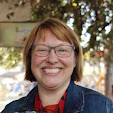Authored By Christy Olsen.
When it comes to 'hue' or color, lighting is everything. Without some form of light, we cannot see color. When lighting conditions are low, we only see 'value,' the lightness or darkness of an object, not the 'hue' or color.

|
| Color of Light |
Whether it's yellow sunlight, blue light reflected from the sky, or orange candlelight, painters are always concerned with the 'hue' or color of the light.
Temperature of Light
Light temperature or 'chromaticity describes the 'hue' or color of the light (or as viewed on a neutral surface illuminated by the light), whether it's warm, cool, or something in between.
Light temperature is rated in Kelvin degrees, one of the seven base units in the International System of Units (SI), assigned the symbol 'K.' It can also be defined by using "XY" coordinates against a standard chromaticity scale determined by the International Commission on Illumination (CIE). Since 2012 all light bulb boxes are now required to tell consumers where the bulbs fall on the color spectrum, so selecting the bulb color/temperature is much easier.
 |
| Measuring the Color of Light |
Not all white light is the same. The lower the Kelvin number, the 'warmer' or more yellow the light. The higher the Kelvin number is, the 'cooler' or bluer the light will be. White light bulbs are usually in the middle of the scale, measuring 3500K to 4100K. It's counter-intuitive, regardless of the light source, because photons themselves have no heat. Not what you would expect if you measured a boiling pot of water or the temperature outside.

|
| Not all white light is the same. |
Daylight Throughout the Day
Daylight experiences color shifts throughout the day. Direct sunlight at noontime is an almost perfectly balanced light source—it contains all colors in nearly equal quantities. The color appearance of objects changes dramatically in the early morning or shade.
The morning sun is a cool yellow; the noontime sun is a warmer yellow; the afternoon sun becomes reddish; the setting sun is orange and casts an orange glow on everything it illuminates.

|
| Natural Light Changes Throughout the Day |
Natural Light in the Studio
There's no substitute for natural light, and artists love to have it in the studio. North-facing windows are the preferred natural light source because these lighting conditions are the most consistent throughout the day. It allows them to get more work done using this natural lighting condition. If windows are east or west-facing, the light changes dramatically from morning until night. East-facing windows see the rising sun (cooler). West-facing windows see the sunset (warmer).
Too much light may be overwhelming and strain the eyes, especially if it is blasting on the white paper or canvas you are working on. You may need some blinds or curtains to control the amount of light coming in.
Quality of Light
CRI, or color rendering index, is a numerical scale (0 to 100) used in lighting to indicate how a light source will make the color of an object appear to the human eye. RI measures the quality of light and is independent of color hue/temperature.
The morning sun is a cool yellow; the noontime sun is a warmer yellow; the afternoon sun becomes reddish; the setting sun is orange and casts an orange glow on everything it illuminates.

|
| CRI measures the quality of light |
If you are looking to purchase lights to work with indoors, you need to determine your end goal before choosing which type of bulb. In many cases, this difference is not essential. However, for specific applications such as illuminating art or comparing fabric in retail clothing stores, CRI can make all the difference. If you have gallery representation, use the same light bulbs so that your representatives can see your work in the same lighting conditions.
The higher the CRI number, the better the color rendering ability, which reduces glare and will equate to sharper, crisper, and more naturally colored objects. Light sources with a CRI of 85 to 90 are considered good at color rendering. Light sources with a CRI of 90 or higher are excellent at color rendering and should be used for tasks requiring the most accurate color discrimination.








